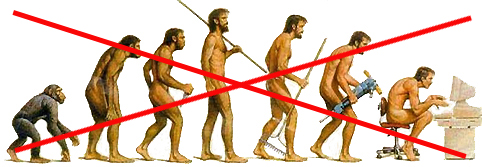Monday, 19 April 2021
Evolution : a branching pattern like a bush, not a linear one

The word “hominids” is often used to refer to the human line that diverged from chimpanzees some 6 or 7 million years ago. It includes not only all the species of the genus Homo, bus also some related genera, such as Australopithecus, that are now extinct. The evolutionary history of our human line has been determined from findings of fossils, some consisting of just a few bone fragments or teeth. These fossils have shown that human evolution has followed a branching pattern, like a bush, and not a linear pattern like you see above, where the chimpanzee starts losing hair, walking more upright, and becomes Homo sapiens, only to end up working hunched over again, first with an industrial tool and then at a computer. There are various versions of this image—some show Homo sapiens in a suit and tie, or riding a bicycle—but all of them convey several false ideas about human evolution.
For one thing, we did not really descend from chimpanzees as we know them today, but rather from an ancestor that we had in common with them and that lived 6 or 7 million years ago. But more importantly, this image suggests that evolution followed a single, straight line, which is just as false for hominids as it is for all other living species. A much more accurate image would show a shrub with many parallel branches growing upward and some of them getting lopped off at various heights, corresponding to periods of massive extinction. The small branches that survived this “pruning” would then continue growing and branching, thus becoming new shrubs in their own right.
Thus, the pattern of evolution of living species looks much less like a tree that still has all of its branches growing upward, and much more like a series of explosions of diversity followed by severe trimmings from which only a few branches escape. It follows that over 99% of the species that ever lived on Earth are now believed to be extinct. So evolution does occur, but not evolution toward anything “better”, and that includes human beings.
Humans, gorillas, rats and grasshoppers are all sufficiently adapted to certain of today’s environments to survive and reproduce in them. The only difference between these other animals and humans is that our ecological niche is especially wide and diverse and that we have more ability than any other species to transform it—ideally to make it more comfortable to live in, but in practice actually doing it more harm than good, in terms of destruction, pollution, diseases, and so on.
For more about all these issues, I recommend the writings of paleontologist Stephen Jay Gould on evolution as a succession of punctuated equilibria and his critique of what he calls the Panglossian view of evolutionary adaptation. His ideas are similar in some respects to those of Francisco Varela and his conception of evolution as a process of natural drift, where the tendency is more to eliminate certain non-viable variants than to evolve into better adapted ones.
Evolution and the Brain | Comments Closed








